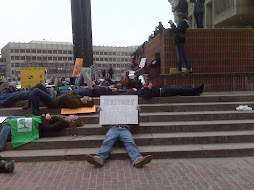Jen Ackerman
WST 3015
Nina Perez
February 23. 2010
""I Am Not a Rapist!"" Women's Lives Multicultural Perspectives. Ed. Gwyn Kirk. Comp. Margo Okazawa-Rey. By John Stoltenberg. New York: McGraw-Hill Humanities/Social Sciences/Languages, 2003. 285-90. Print.
“ I Am Not a Rapist,” by John Stolenberg is a summary and break down of the members from the group MAC ( Men Acting For Change) are striving for. This particular group is from Duke University in Durham, North Carolina, where Stolenberg when to visit the members and talk with them. Stolenberg first explain value in the group MAC and other groups like it. These groups represent a new and growing movement towards men becoming aware and proactive with sexual violence and working to end certain institutions such as rape and abuse against women.
The members in this group were diverse in race and sexuality leading their discussions to have many perspectives. Stolenberg notes that many of boys “ seemed at times to speak on behalf of many more male agemates than themselves” (286). Stolenberg sat down with five members from the MAC group and asked various questions. The men in the group expressed an extensive concern for females being so apprehensive about violence from men, that now there is preconceived fear of every man. The members discusses their personal experiences with sexual violence as well as their opinions on why our society still has to battle it.
Gender role stereotypes is an issue discussed by all the men. One says that he could never understand and thus conform to the definition of “straight” and was then seen as weak because his masculinity was not stressed. Another talked about how popular culture shows women as less intelligent than men, when his experiences were the opposite. One of the men told a story about how he had a female friend who had been raped and after did not feel comfortable about him, simply because he was male. “ It made me angry that this guy had ruined a friendship of mine with somebody I cared about” (288). This specific man was angry and hurt because he was be so easily effected by someone else’s actions based on being the same sex. However he understood this because her trust had not been broken just for that guy that had assaulted her, but lost trust for the whole sex. Many of the men in the group have first hand knowledge of sexual violence happening to friends or themselves, and that is what led them to become active against sexual violence towards women.
One man got the chance to see both sides of sexual violence when his own friend was accused, which led him to realize the intense violence going on everywhere that people just do not recognize. This kind of situation helped him understand the person who committed the act, and how to communicate with them. All of the men interviewed offered how they go about trying to combat the ignorance of sexual violence. Some techniques were finding a balance of listening and challenging, catching men off guard to discuss, or simply by putting them in the situation of sexual violence and showing how powerful it is.
This piece ended with the positive note of ending sexual violence towards women and the incomprehension that surrounds it. These five men all agreed that all men should fight against sexual violence of women because the cycle itself contributes to not only to the inequality of women but also it supports the larger, harmful gender roles shaping society. These men want to end sexual violence but also strive to break free of preconceived expectations of a person based on their biological elements. “People with penises have a lot to gain from the women’s movement, a lot to gain: being able to be exactly who you are without having to be “a man” in the traditional sense” (288).
Discussion Questions: Is sexual violence as prevalent in your life as it is for the members of MAC? Do you think sexual violence is a social problem that most people our age are concerned with? Or is it more ignored or not seen? Can how does sexual violence influence how you see gender roles?
Tuesday, February 23, 2010
Subscribe to:
Comments (Atom)

